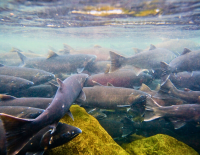Today, Columbia River salmon populations are a fraction of their historic size. The U.S. government eradicated salmon from many parts of the Columbia basin by constructing Grand Coulee, Hells Canyon, and many other dams.
Read or Listen to our Strategic Plan Now:
Our Goals
- Healthy and recovery populations of salmon and steelhead, and recovery of orcas
- Work in solidarity with Tribes to support Tribal Nations’ rights to harvestable salmon runs and meaningful input in regional decisions about salmon recovery and management
- Improve public understanding of leading causes of salmon declines, including combating the racist narrative of Tribal fishing as a leading cause of the extinction crisis
The Problem
The Columbia once produced more salmon than any river on Earth. An estimated 16 million salmon returned to the Columbia from the ocean each year, and Indigenous people sustainably harvested these salmon since time immemorial. The Columbia still supports important subsistence, commercial, and recreational salmon fisheries. Columbia River salmon are also food for critically endangered Southern Resident orcas and other wildlife. Today, Columbia River salmon populations are a fraction of their historic size. The U.S. government eradicated salmon from many parts of the Columbia basin by constructing Grand Coulee, Hells Canyon, and many other dams. Even dams that allow fish migration can take a heavy toll on salmon by damaging habitat and making the water too hot. Despite the dams and other threats, some Columbia River salmon still survive, although many populations are close to extinction.
Our Plan
Advocate for Lower Snake River Dam Removal
The situation is dire. Snake River salmon and Southern Resident orcas are close to extinction—and the people and cultures that rely on them are suffering. We will work with Tribes and partners to convince the federal government to remove the four Lower Snake River dams. As a region, we must unite around solutions to remove the four Lower Snake River Dams and re-invest in regional transportation, irrigation, and energy infrastructure. Working together, we can have a future that includes salmon, agriculture, and clean energy.

Restore Cold Water
Through strategic media, inspiring events, and litigation, we will sound the alarm on the hot-water crisis on the Columbia. This includes using the Endangered Species Act, National Environmental Policy Act, and Clean Water Act to force federal agencies to address temperature impacts on adult salmon migration.
Protect Important Estuary Habitat from Industrialization Recognized as an Estuary of National Significance, the Columbia River estuary is home to some of the most important salmon habitat in the world. We will work with Tribes and river communities to engage in important decisions that will impact the estuary’s health for generations, including proposals to build massive new heavy-industrial ports in Columbia County, OR, and Cowlitz County, WA.
Work in Solidarity with Tribes for Lewis River Fish Passage
The Lewis River basin is famous for salmon, stunning waterfalls, big trees, blurry bigfoot sightings, and hydroelectric power. On its way to the mighty Columbia, the Lewis River flows through three large reservoirs: Yale, Swift, and Merlin. These reservoirs provide electricity and recreational opportunities. But the dams also stop Lewis River salmon and steelhead from reaching their native spawning streams. We will work in solidarity with the Cowlitz Tribe and Yakama Nation to advocate for completion of fish passage throughout the Lewis River basin.
Stop the Destruction of a Sacred Site
For centuries, Yakama ancestors, and current-day descendants, use the area known indigenously as Pushpum to gather foods and medicines that are honored through annual ceremonies. The site is remembered in Yakama legend as a place of refuge for the members of Kah-milt-pa, or the Rock Creek Band. Multiple Tribes consider the area sacred. If built, a proposed pumped-storage hydropower development will excavate and blast nine archaeological sites for the purpose of creating 124 acres of new reservoir surface area. The reservoirs and associated infrastructure will destroy Tribal cultural and religious resources, threaten wildlife, and impact wetlands, streams, and groundwater. We will work in solidarity with the Yakama and other Tribal Nations to convince decision makers to honor Treaty rights and consider environmental justice. This destructive proposal cannot go forward.

